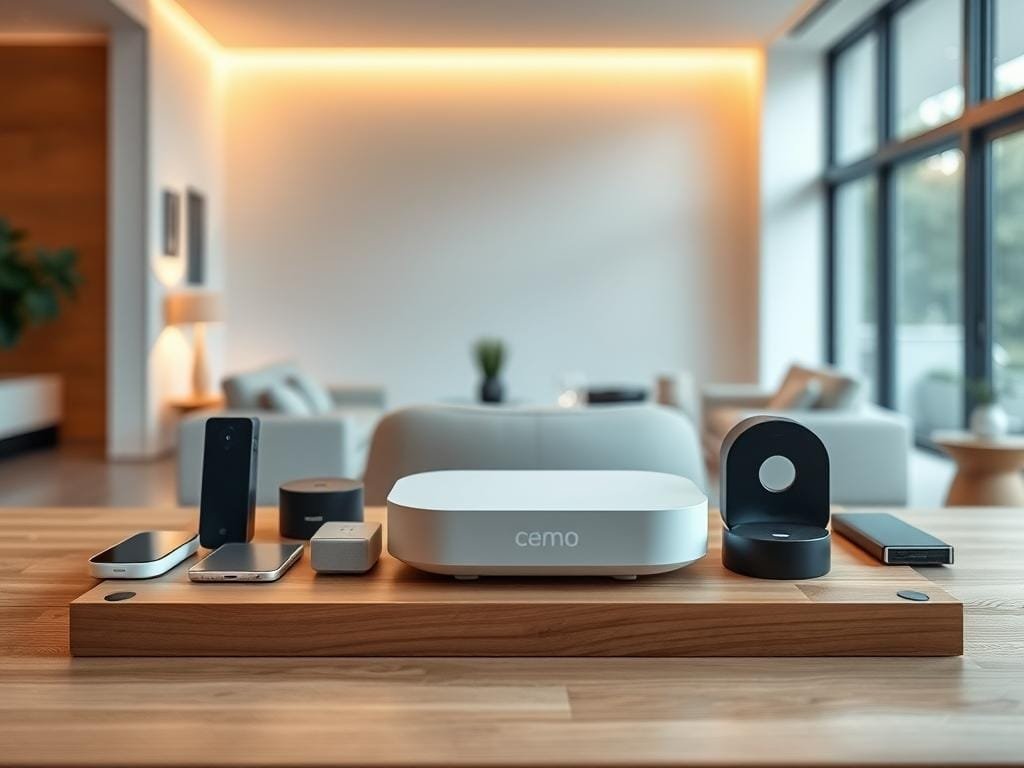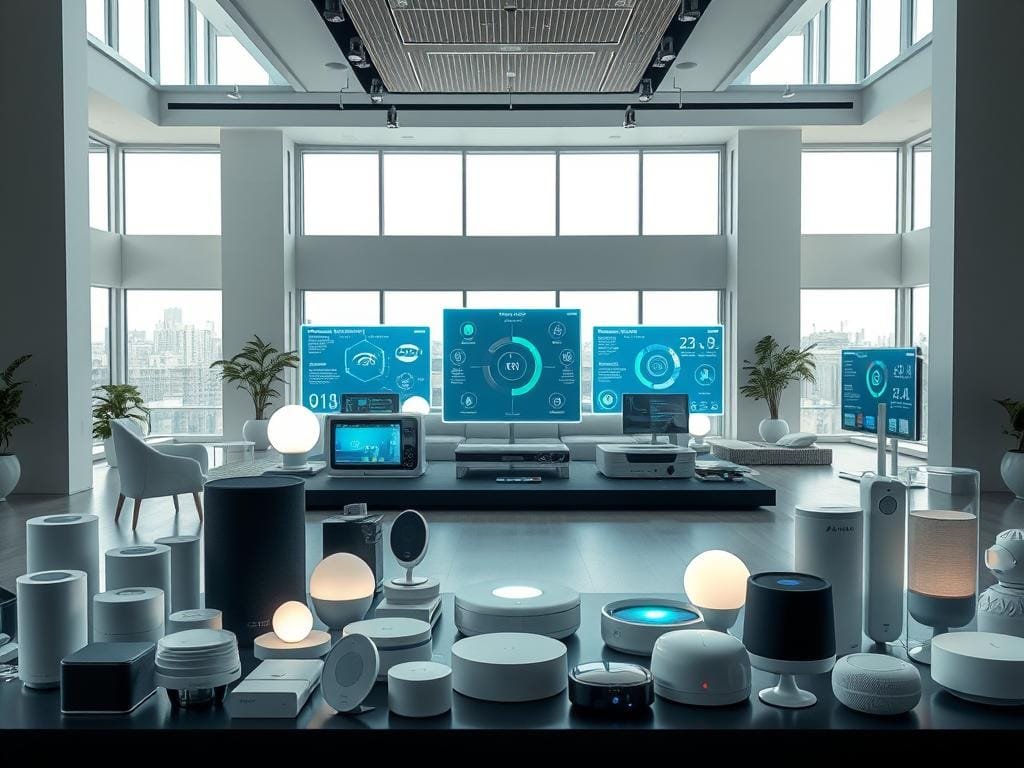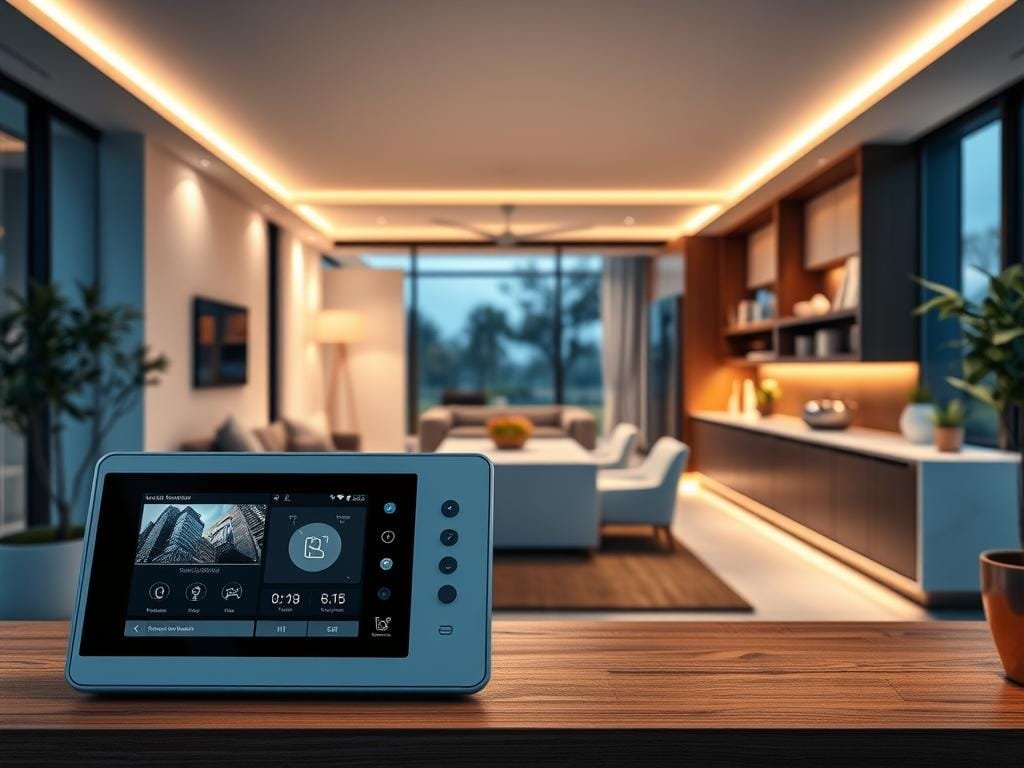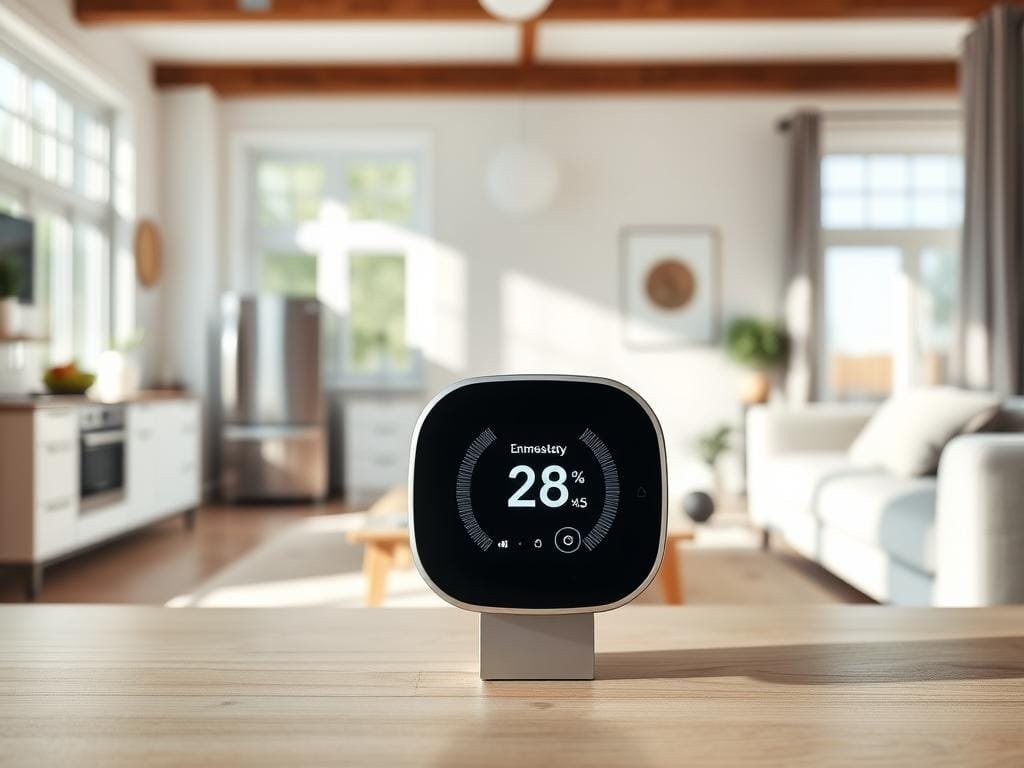Now, 72% of U.S. homes use smart devices. This makes the Connected home a reality for many. It’s key to know the strengths and weaknesses of each platform. With ambient computing on the rise, tech integration is becoming smoother, as seen in the latest trends.
This article will compare the top Smart Home ecosystems of 2025. You’ll learn about the key features, benefits, and limitations of each. This will help you make smart choices for your connected home.
Key Takeaways
- Top Smart Home ecosystems of 2025
- Key features and benefits of each platform
- Comparison of voice assistants and smart HVAC systems
- Interoperability and compatibility issues
- Security concerns and best practices for Connected home owners
What is a Smart Home Ecosystem?
A smart home ecosystem is more than just smart devices. It’s a network that makes your life easier. It connects devices so you can control them from anywhere, making your home more convenient and efficient.
Definition and Key Features
A smart home ecosystem connects IoT devices like voice assistants and smart thermostats. It turns your home into a single, controlled unit. Key features include device compatibility, connectivity standards, and an user-friendly interface.
Experts say, “A smart home ecosystem is not just about smart devices. It’s about how these devices work together to make your life easier.” Learn more about smart home ecosystems.
Benefits of a Smart Home
Smart homes offer many benefits. They make life more convenient, save energy, and boost security. You can control your home’s lighting, temperature, and security from one place, making it easier to manage.
- Convenience: Control your devices remotely
- Energy Efficiency: Optimize energy consumption
- Security: Enhance home security with smart cameras and alarms
Common Devices and Components
Smart homes include devices like smart speakers, thermostats, lighting, and cameras. These devices work together to automate your home. For example, smart thermostats adjust the temperature based on your preferences, and smart lighting turns on/off when you want.
Experts say, “The future of smart homes lies in integrating devices and systems. This creates a truly connected living experience.” This integration makes a smart home ecosystem different from just a collection of devices.
Major Players in the Smart Home Market
A few big names are leading the way in smart home technology. They focus on voice control and working well with smart appliances. Knowing what each offers can help you choose the best for your home.
Amazon Alexa
Amazon Alexa is a big name in smart homes. It lets you control many devices with just your voice. With thousands of compatible devices, it’s a popular choice.
Experts say Alexa’s wide range of supported devices makes it a top choice. Learn more about virtual assistants beyond Alexa.
Google Nest
Google Nest is known for its easy-to-use interface and integration with Google services. Its devices, like Google Home and Nest thermostats, learn your preferences. This makes your home more automated.
Apple HomeKit
Apple HomeKit is secure and easy to use. It lets you control devices with Siri or the Home app. It’s focused on security, but has fewer compatible devices than others.
Samsung SmartThings
Samsung SmartThings supports many devices, from lights to locks. It lets you create custom routines and control devices remotely. It’s great for those with many smart devices.
When picking a smart home system, look at each major player’s strengths. This helps you choose the best for your needs and enjoy a better smart home experience.
Smart Home Integration: How Does It Work?
Smart home integration is key to a smooth and efficient home. It’s important to know how devices talk to each other. This knowledge helps you get the most out of your smart home.
Connectivity Standards
Connectivity standards let different smart devices talk to each other. You’ll find Wi-Fi, Bluetooth, Zigbee, and Z-Wave among others. Each has its own strengths and weaknesses.
For example, Wi-Fi is great for its fast data transfer. But Zigbee is better for its low power use and mesh network abilities.
Many smart home systems support several standards. This lets you mix devices from different brands. This makes your smart home more flexible and powerful. For instance, integrating appliances from various brands works well with the right standards.
Key Connectivity Standards:
- Wi-Fi: High data transfer rate, widely supported
- Bluetooth: Low power consumption, suitable for device-to-device communication
- Zigbee: Low power consumption, mesh network capabilities
- Z-Wave: Low power consumption, reliable for home automation
Device Compatibility
Choosing devices that work well together is essential. Make sure they fit with your current system. Most manufacturers list compatible devices on their websites.
Some systems, like Samsung SmartThings, work with many devices. Others, like Apple HomeKit, focus on quality but have stricter rules. Always check compatibility before buying to avoid problems later.

Setting Up Your Ecosystem
Setting up your smart home needs a few steps. First, pick a central hub or controller. This could be a smart speaker like Amazon Echo or a dedicated hub like Samsung SmartThings.
Then, connect your devices to the hub using their apps or the hub’s interface. Many devices are easy to set up. Make sure all devices are updated to avoid problems.
For better smart security, choose devices with strong security features. For energy efficiency, look for devices that save energy, like smart thermostats and lights.
- Choose a central hub or controller.
- Connect devices to the hub.
- Ensure all devices are updated to the latest firmware.
- Configure device settings for optimal performance and security.
Understanding smart home integration helps you create a better living space. Whether you want better security or to save energy, a well-integrated smart home is key.
Comparing Smart Home Ecosystems
Smart home ecosystems have changed how we live. But, which one is best for you? Knowing the differences is key to making a good choice.
User Interface and Experience
The way you interact with smart home devices matters a lot. Systems like Amazon Alexa and Google Nest make it easy to control your home.
Amazon Alexa offers a voice-controlled experience that’s easy to use. Its design makes managing your devices simple.

Integration with Third-Party Devices
Being able to connect with other devices is important. Samsung SmartThings is great at this, working with many devices from different brands.
- Works with lots of device types
- Supports a wide range of brands
- Updates often to keep compatibility
Voice Assistant Capability
Voice assistants are a big deal in smart home systems. Google Nest and Amazon Alexa are top for their voice skills, making your home smarter.
These assistants do more than just control your devices. They give you info and help, making your smart home life better.
Security and Privacy in Smart Homes
Smart home devices are becoming more common. It’s important to keep them secure and private. As you add more devices, the risks grow too.
Risks and Vulnerabilities
Smart home devices face cyber threats. Weak passwords and outdated software make them easy targets. A hacked smart speaker could let strangers into your home or control your devices.
Common risks include:
- Data breaches and unauthorized data access
- Device hijacking for malicious activities
- Privacy invasion through unauthorized surveillance
To avoid these risks, knowing your smart home’s weak spots is key.
Best Practices for Securing Your Device
To keep your smart home safe, start with strong passwords. Update your devices regularly to stay secure. For more tips, check out our article on building a smart home on a budget.
Additional best practices include:
- Enable two-factor authentication whenever possible
- Limit device access to only those who need it
- Regularly monitor your devices for suspicious activity
Evaluating Ecosystem Privacy Policies
When picking a smart home system, check the provider’s privacy policies. Look for clear data collection and usage policies. A good provider will explain how they protect your data and let you control your privacy.
“Consumers should be aware of the data being collected by smart home devices and have control over how that data is used.” –

Understanding your smart home’s privacy policies helps you make better choices about your data.
Cost of Smart Home Devices
Turning your home into a smart haven comes with a price tag. The cost of smart home devices falls into several categories. Each one plays a big role in your total investment.
Initial Investment and Setup Costs
The cost of smart home devices varies a lot. It depends on the system you pick and how many devices you want. A basic smart speaker might start at $50, but a full security system could be over $500. Remember, the cost of the devices and installation are both important.
Key costs to consider include:
- Device costs
- Installation fees
- Hub or bridge costs (if required)
Long-Term Savings and Energy Efficiency
The initial cost of smart home devices is high, but there are long-term savings. Smart thermostats, for example, can save up to 20% on energy bills. They learn your schedule to optimize heating and cooling.

Smart appliances also save energy. They work better based on your habits and the time of day.
Subscription Services and Ongoing Costs
After you set up your smart home, there are ongoing costs. These include subscription fees for cloud storage, premium features, or security software. Some security cameras need a subscription for cloud storage. Make sure to include these costs in your budget to avoid surprises.
Consider the following when evaluating ongoing costs:
- Cloud storage fees
- Premium service subscriptions
- Maintenance and update costs
By thinking about both the upfront and ongoing costs, you can make smart choices. This way, you can enjoy a more convenient, efficient, and connected home.
Trends Shaping the Future of Smart Homes
Smart homes are changing fast, thanks to new trends. Our homes are getting smarter, more automated, and tailored to our needs. This is all thanks to advancing technology.
Emerging Technologies
New tech is key to smart homes. IoT devices are getting better and cheaper. They make our homes more comfortable, efficient, and secure.
“The Internet of Things is not just about connecting devices; it’s about creating a more intuitive and personalized living experience,” says a leading industry expert. As IoT technology grows, we’ll see more cool stuff in smart homes.
Sustainability and Eco-Friendly Solutions
Smart homes are now focusing on being green. People want to live in a way that’s better for the planet. Smart devices are being made to use less energy, saving money and the environment.
- Smart thermostats that learn your temperature preferences and adjust
- Energy-efficient lighting systems that can be controlled remotely
- Smart home monitoring systems that help detect and prevent energy waste
For more insights on the future of smart homes, you can download a report from Lucintel. It dives deep into the trends shaping the smart home market.
The Role of Artificial Intelligence
Artificial intelligence (AI) is changing smart homes too. AI-powered voice assistants like Amazon Alexa and Google Assistant let us control our homes with voice control. It’s easy and makes our homes smarter.
AI also boosts security and automation in smart homes. For example, AI can spot threats and alert us. It can also make our devices work better based on how we use them.
In conclusion, smart homes are evolving thanks to new tech, green solutions, and AI. As these trends grow, we’ll see even more advanced and connected smart home solutions.
User Reviews and Ratings: What They’re Saying
Thinking about getting a smart home system? It’s smart to see what others say first. Reviews and ratings can show you the good and bad of different systems.
Customer Satisfaction and Experiences
Many people love their smart homes. They say it’s easy to use and super convenient. For example, Amazon Alexa fans love how it works with other devices. Google Nest users like its simple interface and voice control.
A survey found over 80% of smart home users are happy. Those with many devices in their system are even happier than those with just one.
Common Complaints and Issues
Even with all the good, some users have complaints. Here are a few common ones:
- Devices from different makers don’t always work together
- Setting up the system can be hard
- Some worry about their data privacy and security
For instance, some users struggle to connect Apple HomeKit with non-Apple products. Others find Samsung SmartThings hard to set up.
Comparison of User Reviews Across Ecosystems
Looking at reviews from different smart home systems shows some patterns. Here’s a table with average ratings:
| Ecosystem | Average User Rating | Number of Reviews |
|---|---|---|
| Amazon Alexa | 4.5/5 | 10,000+ |
| Google Nest | 4.3/5 | 5,000+ |
| Apple HomeKit | 4.2/5 | 3,000+ |
| Samsung SmartThings | 4.1/5 | 8,000+ |
Amazon Alexa leads with the highest rating, followed by Google Nest. Apple HomeKit and Samsung SmartThings also get good marks, but with fewer reviews. These ratings can help you choose the right smart home system.
In short, reviews and ratings give you a peek into what smart home systems are like. By looking at what others say, you can make a better choice for your home.
Conclusion: Choosing the Right Smart Home Ecosystem for You
Choosing the right Smart Home ecosystem can be tough. There are many options out there. It’s key to think about a few things to make sure you’re happy with your choice.
Key Considerations
Look at how well devices work together and how easy they are to use. Also, think about how well they work with other services. Don’t forget about the lighting you want, like bulbs that change color or outdoor lights.
Future-Proofing Your Investment
Make sure your Smart Home is ready for the future. Choose systems that support new tech and will stay useful for years. This way, you won’t have to spend a lot on updates later.
Final Recommendations for 2025
In 2025, consider Amazon Alexa, Google Nest, or Apple HomeKit. They have great features and work well with many devices. Picking the right Smart Home ecosystem means a better, more fun life at home.
FAQ
What is a smart home ecosystem?
A smart home ecosystem is a network of devices that work together. They automate and control your home’s lighting, temperature, security, and entertainment. This is done using IoT devices and voice control.
What are the benefits of a smart home ecosystem?
Smart home ecosystems offer many benefits. They make your life easier, save energy, and improve security. You also get better control over your appliances and home.
How do I set up a smart home ecosystem?
To set up a smart home ecosystem, start with a central hub like Amazon Alexa or Google Nest. Connect it to your devices. Make sure they are compatible and follow the manufacturer’s instructions.
What is the importance of smart security in a smart home ecosystem?
Smart security is key in a smart home ecosystem. It adds an extra layer of protection. This helps keep your home and devices safe from unauthorized access.
How do I ensure the security and privacy of my smart home ecosystem?
To keep your smart home ecosystem secure and private, use strong passwords and update software regularly. Also, check the ecosystem’s privacy policies to see how your data is used.
What are the costs associated with a smart home ecosystem?
Setting up a smart home ecosystem costs money upfront. There are also ongoing costs like subscription fees and energy use. But, some systems can save you money in the long run by being energy-efficient.
How do I choose the right smart home ecosystem for my needs?
When choosing a smart home ecosystem, think about compatibility with your devices. Also, consider the user interface, voice assistant capabilities, and integration with other devices and appliances.
What are the emerging trends shaping the future of smart homes?
The future of smart homes is exciting. Trends include more artificial intelligence, eco-friendly solutions, and new IoT devices and voice control technologies. These advancements will enhance your smart home experience.
How do I future-proof my smart home ecosystem?
To future-proof your smart home, choose devices and systems that work with new technologies. Look for ones with a history of updates and support. This keeps your home relevant and functional.
What is the role of smart lighting in a smart home ecosystem?
Smart lighting is important in a smart home ecosystem. It saves energy, adds convenience, and improves ambiance. You can control it with voice commands or apps, integrating with other devices and systems.






